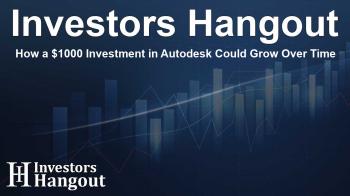How a $1000 Investment in Autodesk Could Grow Over Time

Understanding Autodesk's Financial Growth
Autodesk, known by its ticker ADSK, has shown impressive growth over the last decade, outpacing the market by a significant margin. This growth reflects the average annual return of 19.69%, highlighting the company's effectiveness in generating value for its shareholders. As of now, Autodesk boasts a market capitalization of approximately $67.39 billion, showcasing its substantial presence in the tech industry.
The Impact of Compound Returns
When we discuss investments, the concept of compound returns plays a crucial role. If an investor had decided to commit $1000 to Autodesk stock ten years ago, that same investment would now be valued at $5,942.20, based on current share prices around $315.00. This dramatic increase emphasizes how compounding works, as even modest investments can grow significantly over time.
Looking Back at Autodesk's Performance
Over the last 10 years, Autodesk has consistently demonstrated its ability to innovate and expand its services. The key takeaway is that strategic investments in technology companies like Autodesk can yield impressive returns. Understanding how compounding amplifies your investment can significantly affect your financial decisions.
Key Factors Influencing Growth
Several factors contribute to Autodesk's robust performance. The company's focus on product innovation, customer satisfaction, and market expansion has positioned it well to capitalize on growing demands for its software solutions in various industries. Their continual updates and enhancements to existing products keep them at the forefront of the industry, attracting new customers while retaining current users.
The Future of Autodesk
Looking ahead, Autodesk continues to remain competitive with new product releases and improved customer solutions. Investing in companies that prioritize innovation and customer-centric approaches can potentially lead to fruitful returns. As the digital landscape evolves, Autodesk's ability to adapt will be crucial in maintaining its upward trajectory and market leadership.
Frequently Asked Questions
1. How has Autodesk performed over the last decade?
Autodesk has outperformed the market with an average annual return of 19.69%, demonstrating its strength in the tech sector.
2. What would a $1000 investment in Autodesk be worth today?
A $1000 investment made ten years ago would be worth approximately $5,942.20 today based on current stock prices.
3. What factors contribute to Autodesk's growth?
Factors include consistent product innovations, customer satisfaction, and effective marketing strategies enhancing its market presence.
4. Is Autodesk a good investment opportunity for the future?
Given its history of growth and focus on innovation, Autodesk presents a compelling investment opportunity as it adapts to market changes.
5. How can investors benefit from compounded returns?
Investors can significantly increase their wealth over time through compounded returns, highlighting the importance of long-term investments in strong companies.
About The Author
Contact Ryan Hughes privately here. Or send an email with ATTN: Ryan Hughes as the subject to contact@investorshangout.com.
About Investors Hangout
Investors Hangout is a leading online stock forum for financial discussion and learning, offering a wide range of free tools and resources. It draws in traders of all levels, who exchange market knowledge, investigate trading tactics, and keep an eye on industry developments in real time. Featuring financial articles, stock message boards, quotes, charts, company profiles, and live news updates. Through cooperative learning and a wealth of informational resources, it helps users from novices creating their first portfolios to experts honing their techniques. Join Investors Hangout today: https://investorshangout.com/
The content of this article is based on factual, publicly available information and does not represent legal, financial, or investment advice. Investors Hangout does not offer financial advice, and the author is not a licensed financial advisor. Consult a qualified advisor before making any financial or investment decisions based on this article. This article should not be considered advice to purchase, sell, or hold any securities or other investments. If any of the material provided here is inaccurate, please contact us for corrections.

